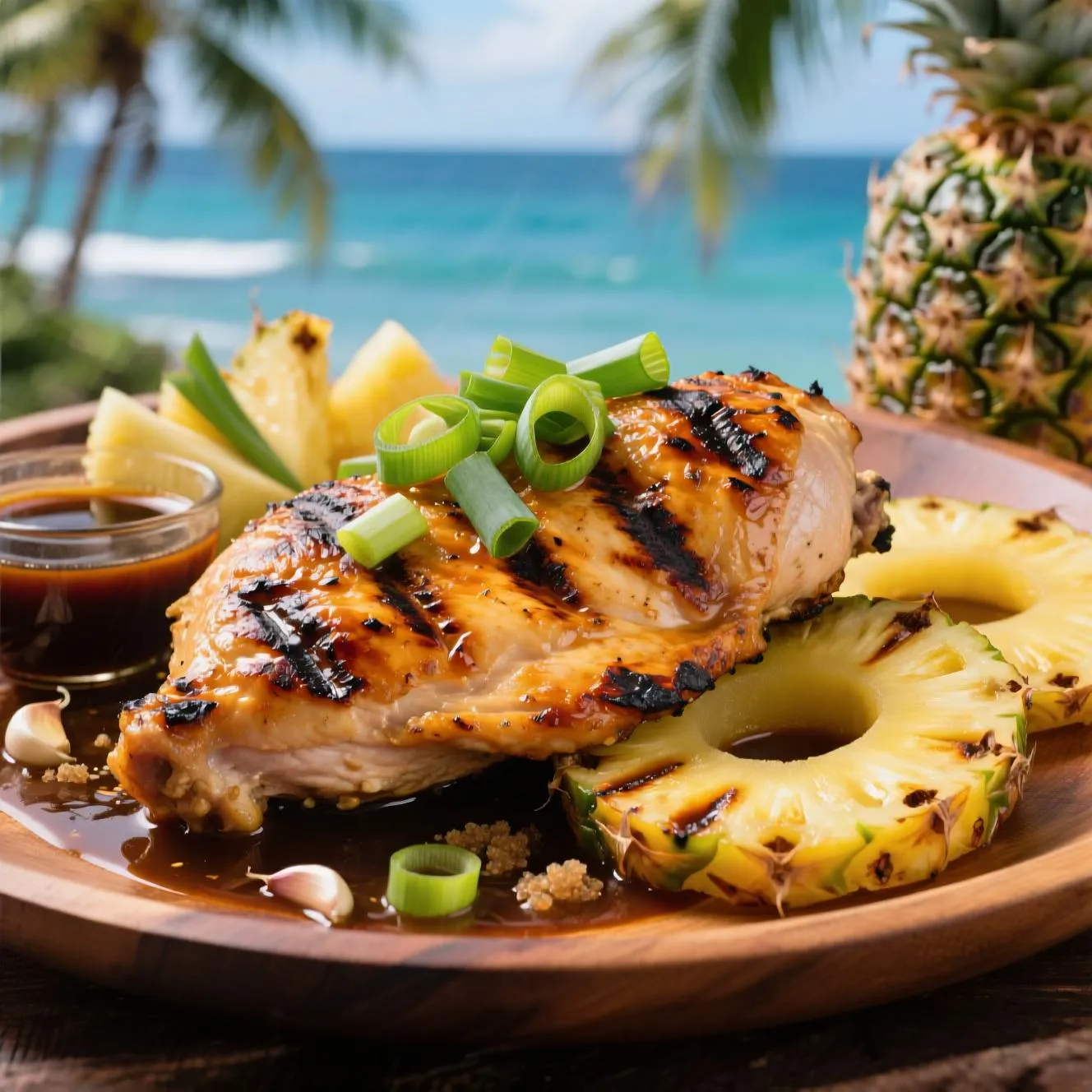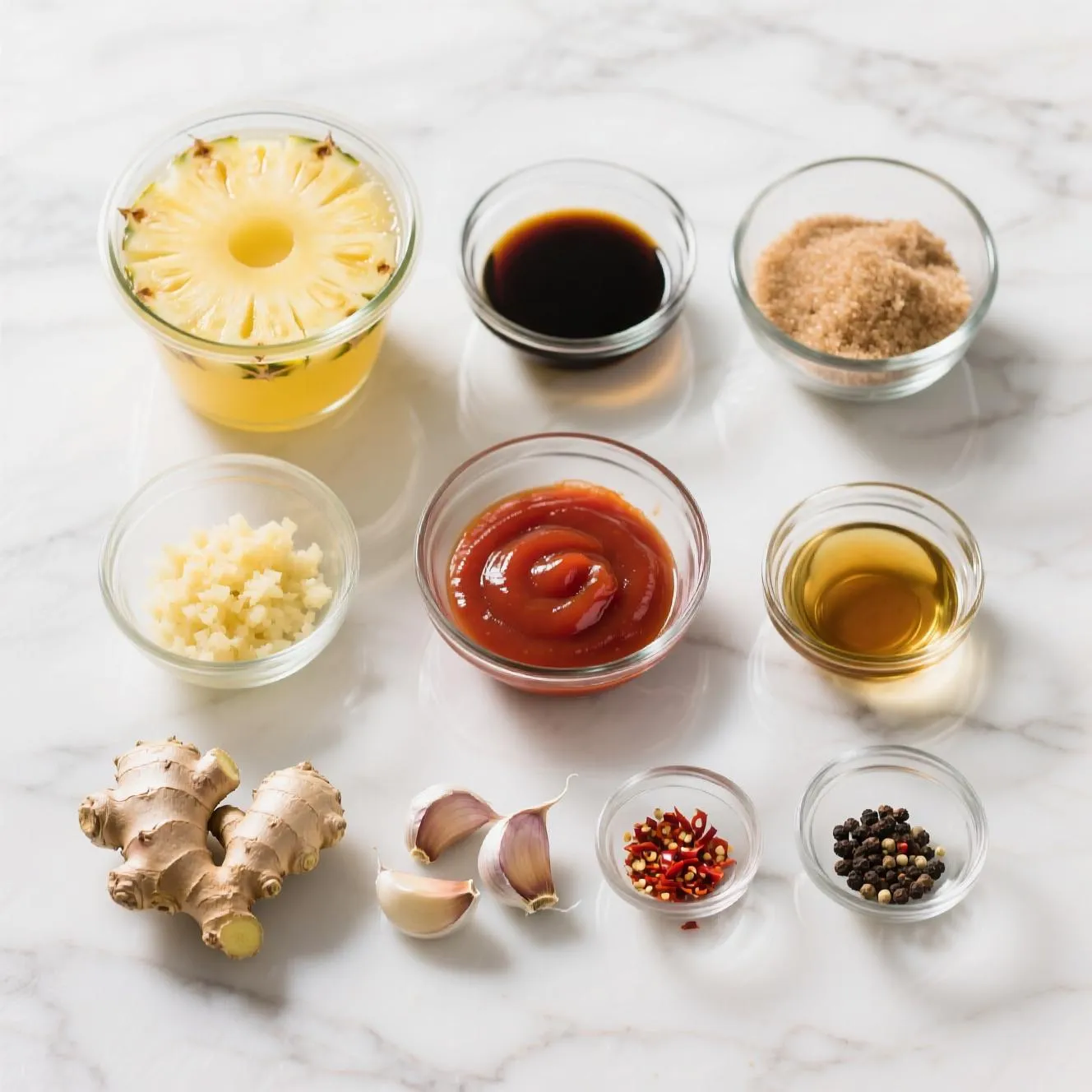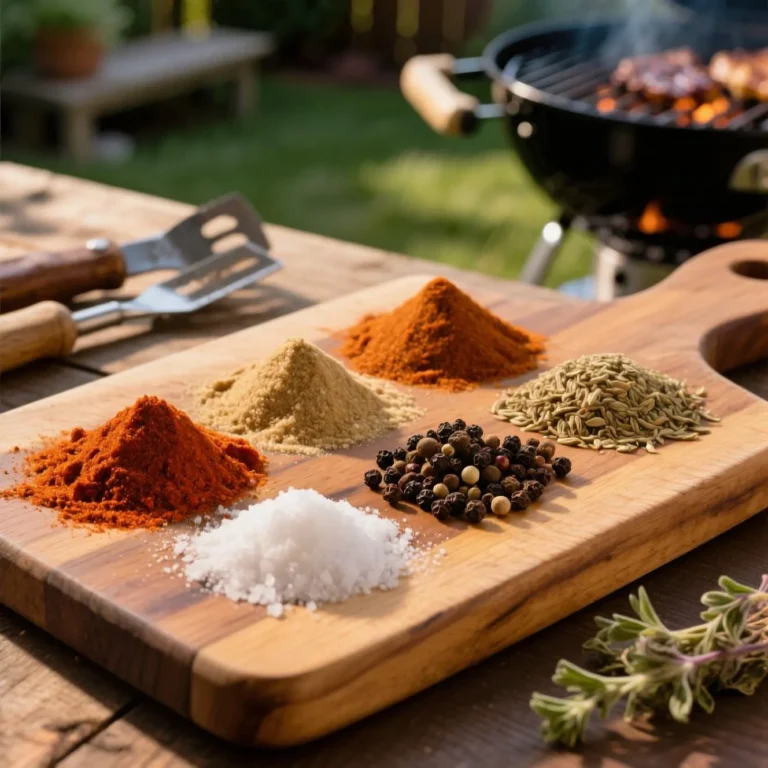Savor the Flavor – Try Our Best Recipes Today!

Hawaiian BBQ Chicken Recipe: The Ultimate Island-Style Grilling Guide
Hawaiian BBQ Chicken : There’s something magical that happens when the sweet aroma of caramelizing pineapple meets the smoky char of perfectly grilled chicken. I discovered this Hawaiian BBQ chicken recipe during a life-changing trip to Oahu fifteen years ago, where a local family invited me to their backyard luau. The patriarch, Uncle Keoni, stood proudly by his grill, basting chicken with a glossy sauce that caught the afternoon sun like liquid amber. One bite transported me – the perfect balance of sweet and savory, with hints of ginger and garlic dancing on my palate. That moment sparked an obsession that led me to spend years perfecting this recipe, consulting with Hawaiian chefs, and understanding the cultural significance behind every ingredient.
This isn’t just another grilled chicken recipe with pineapple thrown on top. True Hawaiian BBQ represents the melting pot of cultures that defines the islands – Japanese teriyaki influences, Filipino adobo notes, Korean kalbi techniques, and traditional Polynesian cooking methods all converging into something uniquely beautiful. Today, I’m sharing not just a recipe, but a complete guide to mastering authentic Hawaiian BBQ chicken that will have your family begging for weekly luaus in your own backyard.
Understanding Hawaiian BBQ: More Than Just a Recipe
The Cultural Heritage Behind the Flavors
Hawaiian BBQ, or “huli huli” chicken as locals often call it, emerged in the 1950s when Ernest Morgado first created his famous marinade for a Honolulu fundraiser. The term “huli” means “turn” in Hawaiian, referring to the constant rotation of chicken over the grill – a technique that ensures even cooking and prevents the sugars in the marinade from burning. What makes this Hawaiian BBQ chicken recipe special isn’t just the ingredients; it’s the philosophy of bringing people together, the patience required for proper marination, and the joy of sharing food prepared with aloha.
What Makes Hawaiian BBQ Unique
The distinctive flavor profile comes from several key elements working in harmony:
- Sweetness from multiple sources: Fresh pineapple juice, brown sugar, and sometimes honey create layers of caramelization
- Umami depth: Soy sauce provides the savory backbone that grounds all other flavors
- Aromatic complexity: Fresh ginger and garlic add warmth and pungency
- Acidic balance: Rice vinegar or lime juice brightens the entire dish
- Optional heat: A touch of chili flakes or sriracha for those who enjoy subtle warmth
Essential Ingredients and Their Roles
The Main Components
For the Chicken:
- 3 pounds bone-in, skin-on chicken thighs and drumsticks (approximately 8-10 pieces)
- 2 tablespoons vegetable oil for coating
For the Marinade:
- 1 cup fresh pineapple juice (never use canned – the enzymes in fresh juice tenderize the meat)
- ½ cup soy sauce (preferably low-sodium to control salt levels)
- ½ cup packed brown sugar
- ⅓ cup ketchup (adds color and tangy sweetness)
- ¼ cup rice vinegar
- 2 tablespoons fresh ginger, minced
- 4 cloves garlic, minced
- 2 tablespoons sesame oil
- 1 teaspoon red pepper flakes (optional)
- ½ teaspoon black pepper
For the Glaze:
- Reserved marinade (we’ll explain the safe handling method)
- 2 tablespoons cornstarch
- ¼ cup water
- 2 tablespoons honey
Garnish and Sides:
- Fresh pineapple rings for grilling
- Sliced green onions
- Sesame seeds
- Lime wedges

Ingredient Deep Dive: Why Each Element Matters ( Hawaiian BBQ Chicken )
Pineapple Juice: The Tenderizing Hero
Fresh pineapple juice contains bromelain, a natural enzyme that breaks down protein fibers, resulting in incredibly tender chicken. This is why using fresh juice makes such a dramatic difference compared to canned versions, which have been heat-processed and lost their enzymatic properties. However, be careful not to marinate too long with fresh juice – beyond 24 hours, the meat can become mushy.
Soy Sauce: The Umami Foundation
The soy sauce doesn’t just add saltiness; it provides glutamates that enhance the savory perception of the chicken. Choose a quality brand, and if you’re watching sodium intake, low-sodium versions work perfectly without sacrificing flavor depth.
Brown Sugar vs. White Sugar
Brown sugar’s molasses content adds complexity and helps achieve that gorgeous mahogany glaze that characterizes great Hawaiian BBQ. The molasses also contributes to better caramelization and adds subtle bitter notes that balance the sweetness.
Step-by-Step Cooking Instructions ( Hawaiian BBQ Chicken )
Phase 1: Preparation and Marination
Step 1: Prepare the Chicken Pat the chicken pieces completely dry with paper towels. Moisture on the surface prevents proper marinade absorption and inhibits browning during grilling. Score the meat with shallow cuts about ¼ inch deep – this allows the marinade to penetrate deeper and creates more surface area for caramelization.
Step 2: Create the Marinade In a large bowl, whisk together pineapple juice, soy sauce, brown sugar, ketchup, rice vinegar, minced ginger, garlic, sesame oil, red pepper flakes, and black pepper. Whisk vigorously for 2-3 minutes until the sugar completely dissolves. The marinade should be glossy and well-integrated.
Step 3: Marinate the Chicken Place chicken in a large zip-lock bag or non-reactive container. Pour ¾ of the marinade over the chicken, reserving ¼ for the glaze (this reserved portion never touches raw chicken, making it safe for later use). Massage the marinade into the chicken, ensuring every piece is thoroughly coated. Refrigerate for minimum 4 hours, ideally overnight, but no longer than 24 hours.
Phase 2: Preparing for Grilling
Step 4: Temperature Management Remove chicken from refrigerator 30 minutes before grilling. This crucial step ensures even cooking – cold chicken on a hot grill leads to burnt exteriors and raw interiors. Room temperature meat cooks more evenly and predictably.
Step 5: Prepare the Glaze Pour the reserved marinade into a saucepan. Mix cornstarch with water to create a slurry, then whisk into the marinade. Add honey and bring to a boil over medium heat, stirring constantly. Simmer for 3-4 minutes until thickened to a syrup consistency. This glaze will be brushed on during the final grilling stages.
Phase 3: Grilling Perfection
Step 6: Set Up Your Grill For this Hawaiian BBQ chicken recipe, two-zone grilling is essential. Create a hot zone (direct heat) and a cooler zone (indirect heat). For gas grills, heat one side to medium-high and leave the other on low. For charcoal, bank coals to one side. Target temperature: 375-400°F on the hot side.
Step 7: Initial Searing Lightly oil the grill grates. Place chicken skin-side down over direct heat. Sear for 4-5 minutes without moving – resist the urge to peek! You want deep caramelization. Flip and sear the other side for another 4-5 minutes.
Step 8: Indirect Cooking Move chicken to the cooler side of the grill. Cover and cook for 20-25 minutes, flipping every 5-7 minutes. This is where “huli huli” gets its name – the constant turning prevents burning while ensuring even cooking.
Step 9: Glazing and Finishing During the last 10 minutes, brush chicken with the prepared glaze after each turn. Move pieces back over direct heat for the final 2-3 minutes to caramelize the glaze. Internal temperature should reach 165°F for breasts, 175°F for thighs and drumsticks.
Step 10: Grilling Pineapple While chicken rests, grill pineapple rings over direct heat for 2-3 minutes per side until caramelized with nice grill marks.
Troubleshooting Common Problems ( Hawaiian BBQ Chicken )
Issue: Burnt Outside, Raw Inside
Solution: Your grill is too hot. Reduce direct heat temperature and rely more on indirect cooking. Use a meat thermometer to monitor internal temperature without cutting into the meat.
Issue: Dry, Tough Chicken
Solution: Either overcooked or under-marinated. Dark meat (thighs, drumsticks) is more forgiving than breasts. Always marinate for the recommended time and don’t exceed 175°F internal temperature for dark meat.
Issue: Marinade Burns Too Quickly
Solution: The sugar content makes burning a risk. Keep a spray bottle of water nearby to control flare-ups. Also, wait until the last 10 minutes to apply the glaze.
Issue: Lacks Flavor Depth
Solution: Probably insufficient marination time or using canned pineapple juice. Always marinate overnight when possible, and invest in fresh pineapple juice – it makes a remarkable difference.
Advanced Techniques and Variations
Oven-Baked Alternative
Not everyone has access to a grill, but you can still achieve excellent results in the oven. Preheat to 425°F, place marinated chicken on a wire rack over a baking sheet, and bake for 35-40 minutes, brushing with glaze every 10 minutes during the last 20 minutes. For extra caramelization, finish under the broiler for 2-3 minutes.
Slow Cooker Method
For incredibly tender, fall-off-the-bone chicken, place marinated pieces in a slow cooker and cook on low for 6 hours or high for 3 hours. Transfer to a baking sheet, brush with thickened glaze, and broil for 5 minutes to develop color and texture.
Ingredient Substitutions
Pineapple Juice Alternatives:
- Orange juice mixed with a tablespoon of vinegar (less tenderizing but still flavorful)
- Mango juice for a tropical variation
- Apple juice with added lime juice for acidity
Soy Sauce Substitutions:
- Coconut aminos for soy-free option
- Tamari for gluten-free needs
- Worcestershire sauce with added salt (different flavor profile but works)
Brown Sugar Alternatives:
- Coconut sugar for lower glycemic index
- Honey (use ¾ the amount as it’s sweeter)
- Maple syrup (adds unique flavor dimension)
Regional Variations
Spicy Hawaiian BBQ: Add 2 tablespoons of sambal oelek or gochujang to the marinade for heat lovers. Include sliced jalapeños during grilling for extra kick.
Teriyaki-Style Hawaiian BBQ: Increase soy sauce to ¾ cup, add 2 tablespoons mirin, and include toasted sesame seeds in the marinade for deeper Japanese influence.
Filipino-Inspired Version: Add 2 bay leaves and 1 tablespoon of vinegar to the marinade, reminiscent of adobo flavors that influenced Hawaiian cuisine.
Serving Suggestions and Pairings
Traditional Accompaniments
The classic Hawaiian BBQ chicken recipe pairs beautifully with:
Coconut Rice: Cook jasmine rice in coconut milk instead of water, adding a pinch of salt and sugar. The creamy richness complements the tangy-sweet chicken perfectly.
Mac Salad: Hawaiian-style macaroni salad with its creamy, slightly sweet dressing is the quintessential side dish. Make it with Best Foods mayonnaise (Hellmann’s on the mainland), apple cider vinegar, and a touch of sugar.
Grilled Vegetables: Zucchini, bell peppers, and onions brushed with the same marinade create a cohesive meal.
Fresh Tropical Salad: Combine lettuce, mango chunks, avocado, and macadamia nuts with a light lime vinaigrette.
Modern Fusion Ideas
Hawaiian BBQ Chicken Tacos: Shred the meat and serve in corn tortillas with pineapple salsa, cabbage slaw, and sriracha mayo.
Rice Bowl Version: Serve sliced chicken over rice with edamame, pickled ginger, nori strips, and a drizzle of the glaze.
Pizza Topping: Use the chicken as a pizza topping with mozzarella, red onions, and fresh pineapple for a gourmet Hawaiian pizza.
Storage and Reheating Guidelines
Proper Storage
Refrigerate leftover chicken in an airtight container for up to 4 days. Store any extra glaze separately in a sealed jar – it keeps for up to two weeks refrigerated and makes an excellent condiment for other dishes.
For longer storage, freeze the cooked chicken for up to 3 months. Wrap individual pieces in plastic wrap, then place in a freezer bag, removing as much air as possible to prevent freezer burn.
Reheating Methods
Oven Method (Best for Maintaining Texture): Preheat to 350°F, place chicken in a baking dish with a tablespoon of water or pineapple juice, cover with foil, and heat for 15-20 minutes until warmed through.
Microwave Method (Quick but Less Ideal): Place on a microwave-safe plate, cover with a damp paper towel, and heat in 30-second intervals until warm. The texture won’t be as good, but it’s convenient for quick meals.
Grilling Leftovers: Surprisingly effective – brush with a little oil or reserved glaze and grill over medium heat for 5-7 minutes, turning frequently.
Nutritional Considerations and Modifications
Healthier Adaptations ( Hawaiian BBQ Chicken )
For a lighter version of this Hawaiian BBQ chicken recipe, consider these modifications:
Reduce Sugar: Cut brown sugar to ⅓ cup and increase pineapple juice slightly. The natural fruit sugars still provide sweetness with fewer calories.
Skinless Option: Remove skin before marinating to reduce fat content by approximately 50%. The meat won’t be as moist, so don’t overcook.
Increase Vegetables: Bulk up the meal with more grilled vegetables to increase fiber and nutrients while maintaining satisfaction.
Portion Control: Serve with a large salad and use the chicken as a protein accent rather than the meal’s centerpiece.
Dietary Adaptations ( Hawaiian BBQ Chicken )
Gluten-Free: Simply substitute tamari or coconut aminos for soy sauce. Ensure your ketchup is gluten-free (most are, but always verify).
Paleo-Friendly: Replace soy sauce with coconut aminos, use coconut sugar instead of brown sugar, and ensure ketchup is paleo-compliant or make your own.
Keto Modification: Substitute sugar with erythritol or allulose, use sugar-free ketchup, and be mindful of the pineapple juice quantity (consider using just a small amount for flavor).
Final Tips for Success ( Hawaiian BBQ Chicken )
( Hawaiian BBQ Chicken ) Mastering this Hawaiian BBQ chicken recipe comes down to attention to detail and understanding the why behind each step. Remember that great barbecue is about patience – rushing the marination or cooking process will yield inferior results. The beauty of Hawaiian BBQ lies in its balance of flavors and the joy it brings to gatherings.
Don’t be afraid to adjust seasonings to your family’s preferences. Some like it sweeter, others prefer more savory notes. The recipe I’ve shared is a perfect starting point, but cooking is about making food that brings happiness to your table. Each time you prepare this dish, you’re not just making dinner – you’re creating memories, sharing culture, and bringing a taste of aloha into your home.
The transformation from raw chicken to glossy, caramelized perfection represents more than just cooking; it’s an act of love, patience, and respect for ingredients and tradition. Whether you’re preparing this for a summer barbecue, a family dinner, or meal prep for the week ahead, this Hawaiian BBQ chicken will deliver consistent, delicious results that transport you to the islands with every bite.



